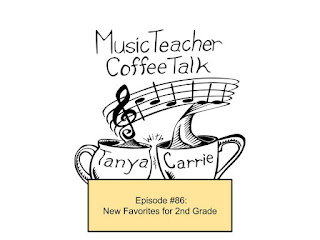Episode#122: PPP: All about Practice
Upcoming Events!
Come see Carrie and Tanya at these upcoming workshops and events!
Carrie will be presenting "Keep them singing! Keep them playing!" in Seattle, WA
Carrie and Tanya will be presenting "Kodály 101 for the 21st Century Teacher" in Fort Collins, CO
Main Theme: PPP: All About Presentation
We are continuing our series where we'll be focusing on the 3 stages of learning commonly found in a Kodály-inspired class: Prepare, Present, Practice. This episode is all about Practice. Carrie and Tanya share specific ideas for songs and activities to practice a melodic or rhythmic concept.
What is practice? Once students know the name, symbol, and function of a new rhythmic melodic or rhythmic element we can go deeper with our understanding to make sure this element is now part of our musical vocabulary. In the practice stage we are working on music literacy, fluency, and creativity through reading and writing, memory and inner hearing, part-work and ensemble, and improvisation and composition.
Practicing re
Great songs for practicing re:
New song for late practice of re:
Sample Practice activities for re:
- Reading: Read songs with re in stick notation and staff notation
- Writing: Students write songs and patterns on individual staff boards with dry erase markers, circle bingo chips, or mini erasers.
- Writing: Students write songs and patterns on a staff in Seesaw and then record themselves singing for an assessment.
- Memory and Inner Hearing: Play Poison Pattern games with melodic patterns containing re. Can be aural or visual.
- Partwork: Add a melodic ostinato (ie: the last phrase of Bow Wow Wow). Have students sing the ostinato first before playing on an instrument.
- Composition: Students can create a small melodic composition with re. Give students a simple 8-beat rhythm and ask them to add the solfa, first in stick notation and then write in staff notation.
Practicing ti-tika:
Great songs for practicing ti-tika
The Tailor and the Mouse
New songs for late practice of ti-tika:
Sample practice activities for re:
- Reading: Students read known and new songs with ti-tika rhythms demonstrating rhythmic fluency.
- Reading/Improvisation: Students place a ti-tika card on one beat of a 4-beat rhythm. All other beats are ta. Students can then place their ti-tika on a different beat and then improvise the other beats.
- Writing: Students write 4-beat rhythmic dictation using ti-tika.
- Partwork: Have one group do the beat and another do the rhythm, either with body percussion or on percussion instruments.
- Inner Hearing: Students read songs and rhythms, but put the ti-tika "in their head" rather than speaking or singing out loud.
Stations/Centers are a great way to practice a melodic or rhythmic element because you can have students reading, writing, decoding, playing, and creating music using that particular element in fun and engaging ways. If you are interested in specific ideas for implementing stations into your music room, check out MTCT episode #109: Learning Stations
Know Better, Do Better
Tanya recommends checking out a few new publications:
Realizing Diversity: An Equity Framework for Music Education by Dr. Karen Howard
Honoring Trans and Gender-Expansive Students in Music Education by Matthew L. Garrett and Joshua Palkki
Work Smarter, Not Harder
Carrie reminded us of the importance of good communication for families regarding upcoming performances and other information you are sending home. Carrie has a "rule of 3" in which all information needs go home at least 3 times and in various modalities: paper copy notes, email, school or music room website, bulletin board with QR code, school marquee board, school newsletter, etc. This will hopefully alleviate confusion and frustration in the long run.
Coda
Tanya recommends the audiobooks for the Arc of a Scythe series
Carrie recommends the Music Room podcast, especially Episode #85: Favorite Music Education Resources
.jpg)



%20(4).jpg)


Comments
Post a Comment